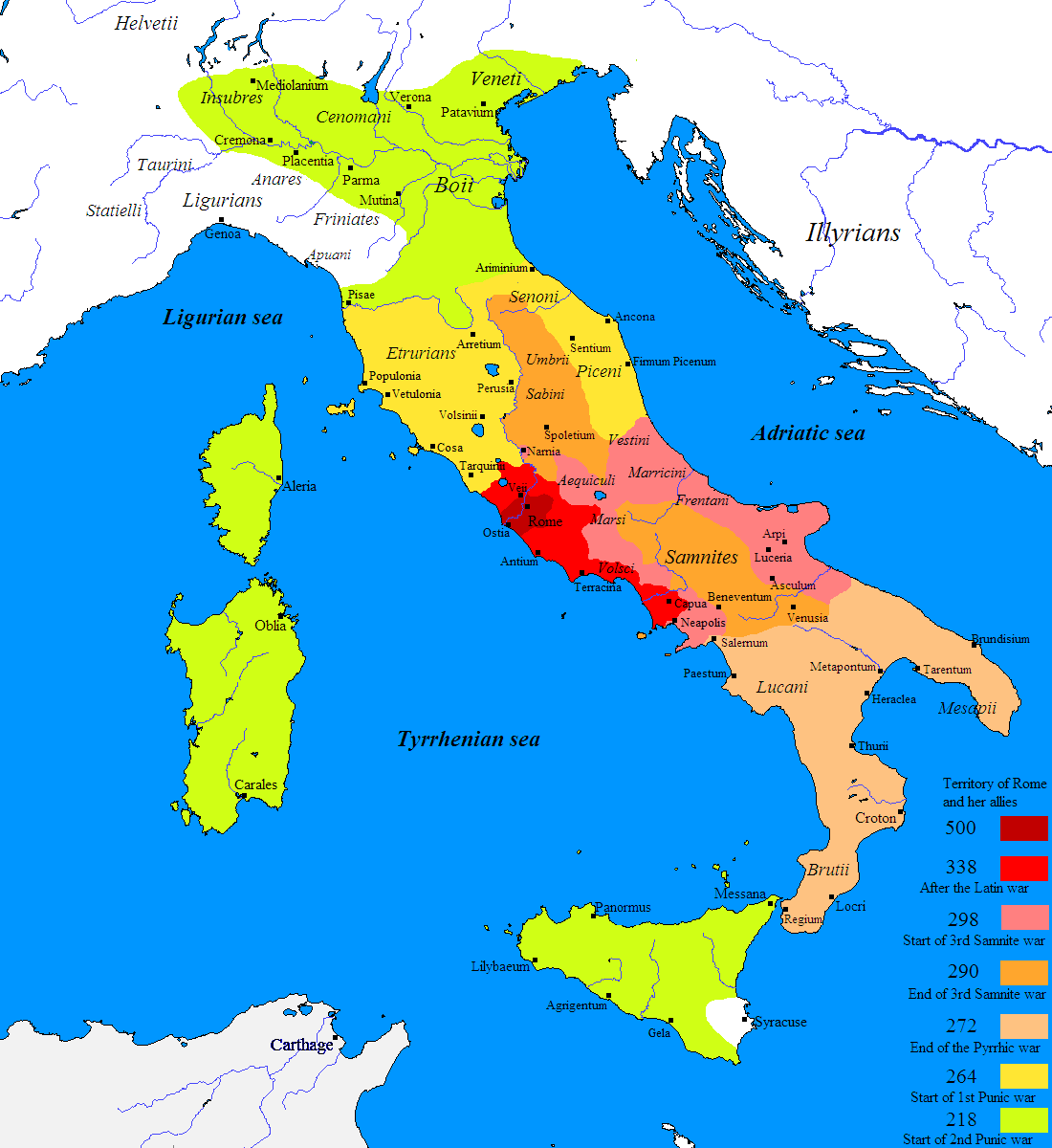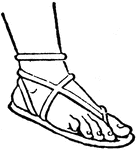I read this book right after I read his "Early History of Rome" - and that was quite some time ago. Again, to salvage what I could from my memory (thanks to my margin markings), here is what I got from this piece. Spoilers ahead, many spoilers. But then, it's not like there are any secrets here...
Rome and Italy
Livy
 This book continues from Livy’s “The Early History of Rome” with five subsequent ‘books’ - 6 through 10. This work covers the period from the Gallic (Celtic) sack of Rome in 386 B.C. until when the Romans began dominating most of Italy in 292 B.C.
This book continues from Livy’s “The Early History of Rome” with five subsequent ‘books’ - 6 through 10. This work covers the period from the Gallic (Celtic) sack of Rome in 386 B.C. until when the Romans began dominating most of Italy in 292 B.C.
Book Six re-summarizes some of the events leading up to and following the Gallic sack of Rome. Important figures were Roman general Camillus, who defeated the Gauls, and defended Rome against local rivals as Rome slowly recovered from the Celtic defeat, and Manlius, a former Consul who had aspirations of the throne, and was executed. (However, this may have been just a story to cover the fact that he championed the plebeians to the disgust and anger of the patricians.) In 367 B.C., the Gauls made another attack, but were easily defeated by the Romans this time.
Book Seven covers the period from 365 to 342 B.C. Socially, rebuilding the city was a crushing financial burden to the plebeians, so changes to the rate of interest improved their lot. Militarily, just 17 years after the defeat, the Romans were able to field 10 legions. Around 350 B.C. a large Gallic army again appeared in Latin territory, and was defeated with great loss to the Gauls. Greek pirates made a show near the mouth of the Tiber, but were easily defeated when they landed. Also covered is the first conflict with the Samnites of south and central Italy, with the Romans winning several battles.
Book Eight Covers the period from 341 to 322 B.C. generally known as the first Samnite war. However, it begins with another short battle with the Volscians. Livy takes the opportunity here to describe the make-up and fighting strategy of the Roman army. A good time because the Romans now had to fight some of their fellow Latins, who had long been allies, and with whom they had fought side-by-side, and used the same weapons and techniques. The Romans won, with the unlikely aid of the Samnites, but at great cost to both sides. Rome would recover, and retain much of the territory of the vanquished Latins. And of course, more fighting against the Samnites.
Livy mentions the rise of Alexander the Great at this time, as well as the founding of the city of Alexandria in Egypt. And in 326 B.C., the Romans made a law that a creditor may seize the property of a debtor, but may not seize or imprison the debtor’s person.
Book Nine Covers the period from 321 B.C. to 304 B.C., generally known as the second Samnite war. It starts with the Roman army coming to the aid of allies being besieged by the Samnites. On their way they are ambushed by a Samnite army, and forced to give up hostages (their cavalry), to strip their uniforms and their arms, and to proceed under the yoke. Here is a paining of the event (click for more info).
 |
| Romans passing under the Samnite yoke |
Having considered two options - let the Romans go, and guarantee friendship, kill them all, and guarantee a weakened Rome for a generation, they instead chose to humiliate- a decision that would do them no good in the end.
A second Roman army laid siege on an Apulian city garrisoned by Samnites and won a victory, freeing the hostages, and forcing Samnites under the yoke. The general here was Papirius Cursor, whom Livy insists could have bested Alexander the Great, had he came the way of Italy. (A bit of hubris, perhaps?)
After some treaties with Samnites and some lesser Greek cities (in the east and south of Italy), the Romans began sending envoys (patrons) who purpose was to introduce Roman law, and thus began the spread of Roman law (and culture) though Italy. As the second Samnite war drew to a close, the Romans began to be concerned with the Etruscans, and they began fighting on two fronts. Etruscans had great numbers, but were not as organized, and soon paid a heavy price for that, after which the Romans granted them a 30 year truce. At the same time, the Samnites prepared for a great push, but were badly beaten, and agreed to supply Rome with corn and payments. Livy mentions that at this time a treaty with Carthage was agreed to, extended for a third time.
 |
| Roman Conquest of Italy |
Book Ten Covers the period from 302 B.C. to 292 B.C. Generally know as the third Samnite war. Starts with the Aequi revolting and being crushed, followed by the invasion of a small town in the east by Spartan Greeks, who were beaten quickly and driven back to their ships. The Marsi were also put down, and so were the Etruscans again. Finally, on suspicious grounds, the Romans decided to war again with the Samnites. In 296 B.C., the Romans faced the combined forces of the Etruscans, Samnites, Umbrians and Gauls- it seems that the Romans were on a rampage, and they were generally feared by all in Italy. Again in battle, both Samnites and Gauls were fierce, but lacked technique, and were defeated in long, pitched battles. Livy says that the Romans defeated combined armies of 600,000 infantry and 45,000 horse, but implies that these numbers may not be reliable. After more skirmishes (where many thousands more fell), the Samnite armies were wiped out, and the Romans were left to besiege their cities.
After this book, presumably Livy covers the final Roman dominance over the whole of Italy, but Books 11 thru 20 are lost to history. Fortunately, others covered this period.
This book was very similar in style to the first, and to be fair, the arrangements of books are a function of the translation, so the similarity is no surprise. I still really liked this subject matter, so I had to give it 4 stars again...
4 starts out of 5 ****
 I waited a long time to read this book, and I was a little disappointed. I guess if many people say that it is one of the best science fiction books ever, how can you live up to that? This is my 3rd Heinlein book, and I’d say that it falls in the middle between Starship Troopers (very good) and Stranger in a Strange Land (quite disappointing). I could identify with all the characters in The Moon is a Harsh Mistress, but it was less a sci-fi book than it was a political revolution thriller, with a sci-fi back-drop. Now that’s not completely fair, since one of the main characters was an intelligent computer, but it was mostly about revolution.
I waited a long time to read this book, and I was a little disappointed. I guess if many people say that it is one of the best science fiction books ever, how can you live up to that? This is my 3rd Heinlein book, and I’d say that it falls in the middle between Starship Troopers (very good) and Stranger in a Strange Land (quite disappointing). I could identify with all the characters in The Moon is a Harsh Mistress, but it was less a sci-fi book than it was a political revolution thriller, with a sci-fi back-drop. Now that’s not completely fair, since one of the main characters was an intelligent computer, but it was mostly about revolution.













